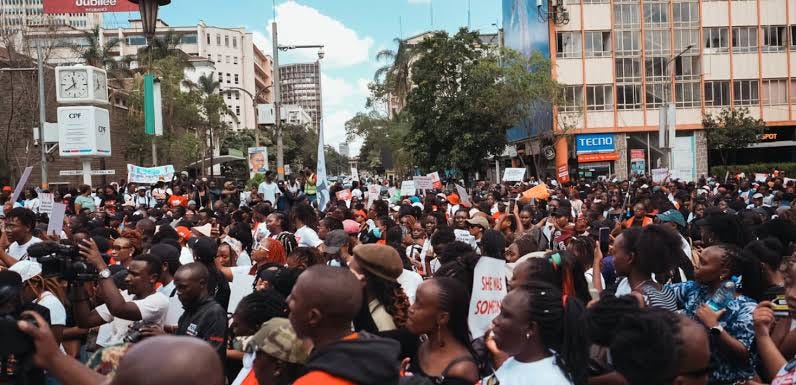📌 Author’s Note
This piece was originally written in the immediate aftermath of Kenya’s June 2024 protests. As I share it now in July 2025, its urgency remains—and perhaps gains new meaning in hindsight. Consider this both an archive and an argument.
What transpired in Kenya in June 2024 was not merely a moment of mass protest. it was the collision of citizen consciousness with the engineered inertia of state power. And what has followed is not peace, but an orchestrated silence; not reconciliation, but a strategic erasure.
Within days of the occupation of Parliament, the state's machinery—legal, symbolic, and violent—was activated. But its aim was not to suppress dissent entirely. Rather, it was to disfigure it: to strip the protests of their political legitimacy and recode them as chaos, criminality, or treason. This is not new. It is the logic of power when faced with an uprising that does not speak in the language of official opposition.
Disruption and its Neutralization
The withdrawal of the Finance Bill was not a concession. It was a calculated maneuver—a pacification strategy designed to re-establish hegemony through the illusion of responsiveness. By framing the withdrawal as a listening gesture, the regime repositioned itself not as a coercive state under pressure, but as a benevolent one willing to “listen.” The public celebration that followed, while sincere, became an involuntary performance within a simulation of democracy.
This phenomenon aligns with what Achille Mbembe identifies as “postcolony-as-spectacle” where power asserts itself not just through violence, but through theatricality. The abrupt cabinet reshuffle that followed, framed as accountability, was part of this performance. In reality, it reinstalled state control by substituting symbols without altering structures.
A woman interviewed in Eldoret captured the popular sentiment: “Let him not even dream of being a village elder.” It was more than disapproval. It was rejection of symbolic politics masquerading as reform.
Memory as Terrain of Struggle
Revolutionary moments often falter not because of external force, but because of a crisis of political memory. After June, this was evident.
The crowds dissipated not solely due to fear, but because the infrastructure for collective memory had not yet been built. The Kenyan protestor operates under persistent precarity—not only economic, but epistemic. The momentum of dissent was corralled into manageable formats: electoral commentary, side jokes, and fatalistic humour.
WhatsApp groups went dormant. X (formerly Twitter) filled with distractions. The affective infrastructure collapsed. Here, power succeeded, not by crushing the people, but by exhausting them.
Necropolitics in the Kenyan Context
While the president gave assurances of legality, the state apparatus remained committed to extra-legal violence. Protestors and organizers were abducted in unmarked cars. Bodies were later found in rivers, swamps, and disused mine shafts. In many cases, they were not even named.
The discourse of state violence shifted quickly: from bodies to broken glass, from loss of life to loss of business. This is necropolitics in the African postcolony. it shows itself not just in the the right to kill, but the right to obscure who died, and why.
And what of the clergy, civil society, the self-proclaimed moral authorities of the nation? They were either silent or complicit, retreating into “prayers for peace” that carefully avoided naming the dead or confronting the state.
It must be said plainly: there can be no ethical neutrality in the face of state-orchestrated death. Silence is endorsement.
The Logic of Premature Repression
The use of state force was not reactive, but pre-emptive. The regime read the protests for what they were. A rupture in the logic of Kenya’s political culture. Not tribal. Not elite-sponsored. Not beholden to electoral outcomes.
It is in this context that the deployment of the military, the invocation of treason, and the tactical killings must be understood. These were not acts of desperation. They were expressions of political rationality aimed at preserving dominance.
When confronted with decentralized, organic resistance, the state does not negotiate. It erases.
Symbolic Power and the Biblical Metaphor
Political violence often masquerades as historical inevitability. But consider this: Herod did not fear armies. He feared a child. He feared the symbolic rupture.
In the same way, our government did not respond violently because protestors posed a military threat. It responded violently because protestors posed a narrative threat.
What took place in June was not a coup attempt. it was a cultural intervention. A re-articulation of sovereignty from below. In a nation where protest is often filtered through political patrons and tribal dialects, the Gen Z-led movement signified a loss of control over the script.
And power, when it loses narrative control, turns homicidal.
The Incomplete Rebellion and the Tasks Ahead
The protests exposed a critical reality: crowds can occupy space without capturing power. It is not enough to be visible. The Kenyan political class, honed by decades of elite consensus, knows how to absorb public anger, perform contrition, and continue with business as usual.
Yet something shifted. For a brief period, we witnessed the formation of a new political imaginary. Young people coordinating without tribal frameworks. Protestors articulating demands in constitutional language. A movement animated by its own logic, not that of the ruling class.
This must be preserved—not through nostalgia, but through organization.
The apparatus of forgetting is already at work: in the media, in the pulpits, in parliament. But if memory is cultivated and politicized, it can be weaponized. What happened in June is not over. It is suspended, waiting to be reactivated by history.
We owe it to the dead not to mythologize them, but to vindicate them. This means building a political culture that cannot be simulated, bought, or silenced.
And we must begin now.




